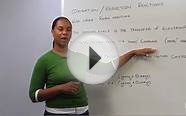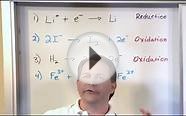
Oxidation reduction reactions examples
Problem : \( MnO_4^- + I^- \rightarrow I_2 + Mn^{2+} \)
Steps to balance :
1) Separate the half-reactions that undergo oxidation and reduction.
Oxidation: \( I^- \rightarrow I_2 \)
This is the oxidation half because the oxidation state changes from -1 on the left side to 0 on the right side. This indicates a gain in electrons.
Reduction: \( MnO_4^- \rightarrow Mn^{2+} \)
This is the reduction half because the oxidation state changes from +7 on the left side to +2 on the right side. This indicates a reduction in electrons.
2) In order to balance this half reaction we must start by balancing all atoms other than any Hydrogen or Oxygen atoms.
Oxidation: \( 2I^- \rightarrow I_2 \)
In order to balance the oxidation half of the reaction you must first add a 2 in front of the I on the left hand side so there is an equal number of atoms on both sides.
Reduction: \(MnO_4^- \rightarrow Mn^{2+} \)
For the reduction half of the reaction, you can notice that all atoms other than Hydrogen and Oxygen are already balanced because there is one manganese atom on both sides of the half reaction.
3) Balance Oxygen atoms by adding H2O to the side of the equation that needs Oxygen. Once you have completed this step add H+ to the side of the equation that lacks H atoms necessary to be balanced.
Oxidation: \(2 I^- \rightarrow I_2 \)
Because there are no Oxygen or Hydrogen atoms in this half of the reaction, it is not required to perform any kind of balancing.
Reduction: \( MnO_4^- \rightarrow Mn^{2+} + 4 H_2O \)
The first step in balancing this reaction using step 3 is to add4 H2O atoms in order to balance the Oxygen atoms with the 4 on the other side of MnO4-
Reduction: \( MnO_4^- + 8 H^+ \rightarrow Mn^{2+} + 4 H_2O \)
Now that the Oxygen atoms have been balanced you can see that there are 8 H atoms on the right hand side of the equation and none on the left. Therefore, you must add 8 H+ atoms to the left hand side of the equation to make it balanced.
4) Now that the two half reactions have been balanced correctly one must balance the charges in each half reaction so that both the reduction and oxidation halves of the reaction consume the same number of electrons.
Oxidation: \( 2 I^- \rightarrow I_2 + 2e^- \)
Because of the fact that there are two I's on the left hand side of the equation which a charge of -1 we can state that the left hand side has an overall charge of -2. The I on the left side of the equation has an overall charge of 0. Therefore to balance the charges of this reaction we must add 2 electrons to the right side of the equation so that both sides of the equation have equal charges of -2.
Reduction: \( 5 e^- + 8 H^+ + MnO_4^- \rightarrow Mn^{2+} + 4 H_2O \)
Looking at the left hand side of the equation you can notice that there are 8 Hydrogen atoms with a +1 charge. There is also a MnO4- ion that has a charge of -1. When we add these two charges up we can calculate that the left hand side of the equation has an overall charge of +7. The right hand side has an Mn atom with a...
You might also like




|
Bio-Kleen M00707 Oxidation Remover, 32 oz. Automotive Parts and Accessories (Bio-Kleen)
|





